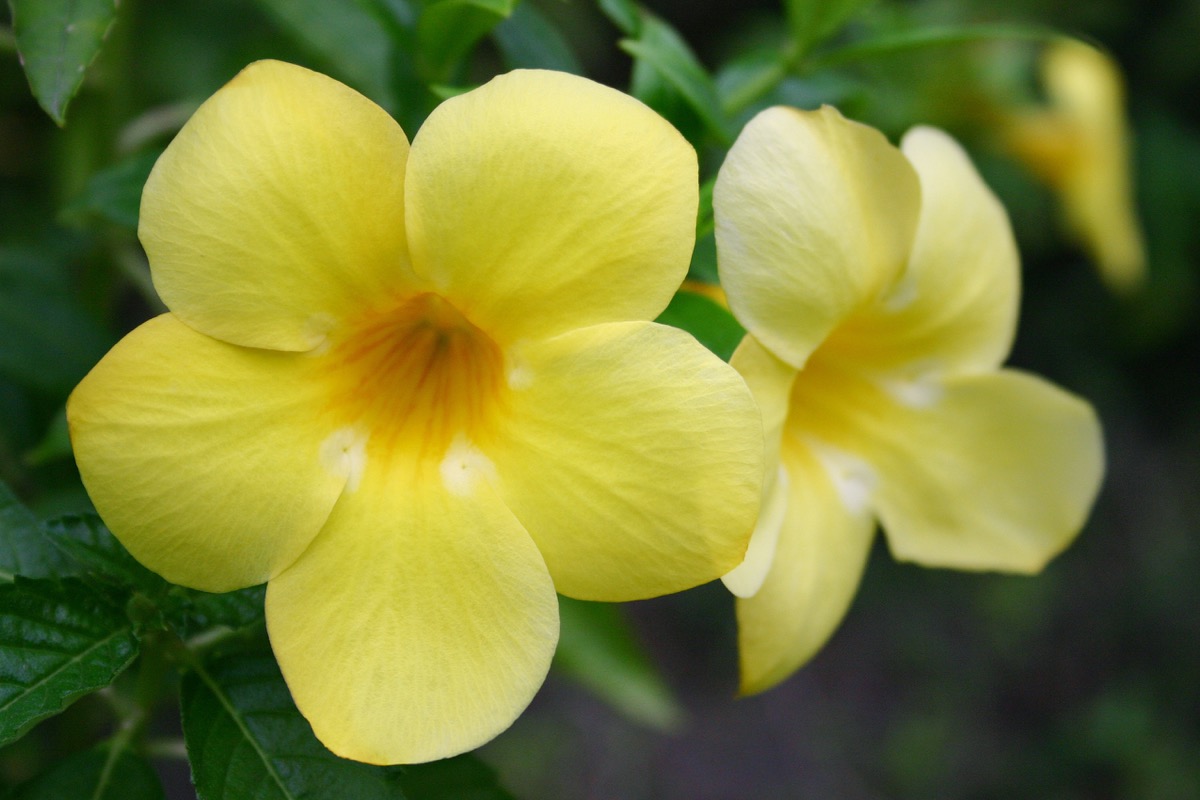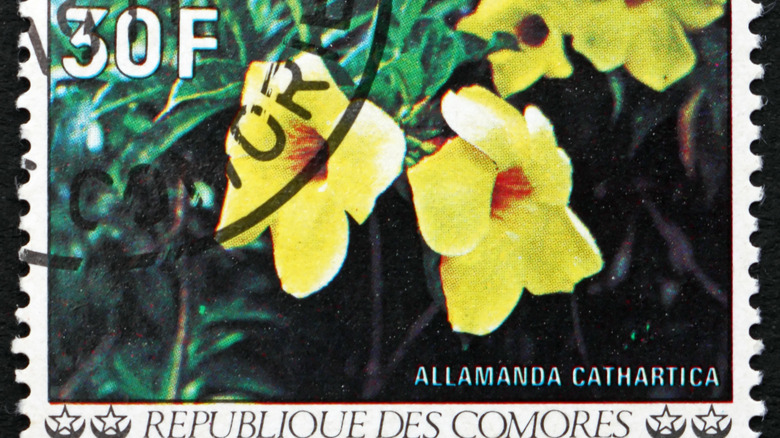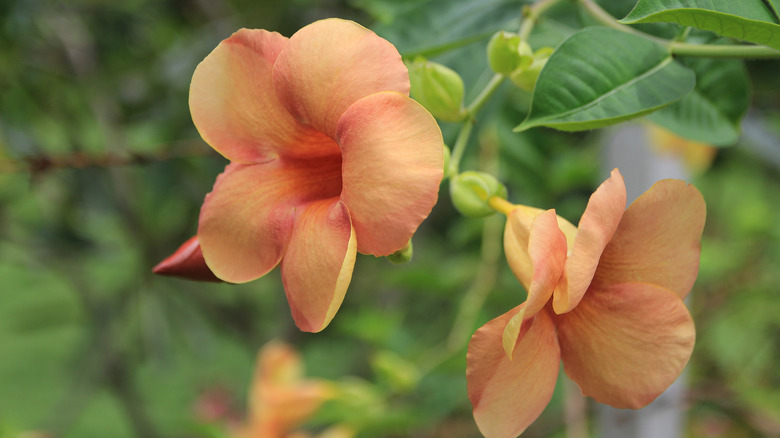Most often referred to as the golden trumpet, Allamanda cathartica is a flowering vine native to Central and South America. It was first described and classified by the great Carl Linnaeus, considered one of the most influential and important botanists in history, as per the University of California, Berkeley. He named this robust flower after Dr. Frédéric-Louis Allamand, a fellow botanist and friend from Switzerland. Bright yellow is the most common color for allamanda flowers, hence the golden nickname, but you can also find the blooms in gorgeous shades of pink and peach.
Kew Royal Botanical Gardens describes the leaves of the allamanda as lance-shaped, meaning they taper from base to tip. Individual leaves tend to grow a few inches long and about 1 inch wide. That size pales compared to the glorious trumpet-shaped blossoms, which can be close to 4 inches long and over 2 inches wide. Each vine of this often mammoth-sized plant has the potential to stretch well over 20 feet high.
Fifteen Allamanda species have been classified so far; the latest discovery occurred in 2009. Even though this happened in Brazil, where the plant is commonly found, research shows that the original introduction of the golden trumpet vine made its way to South America from Africa as many as 20 million years ago. These days, allamandas have spread across the globe and naturalized themselves into many tropical locations, including the rainforests of Queensland, Australia. They are popular in USDA hardiness zones 10 and higher within the United States, where you can find them gracing many a landscape in places like South Florida and much of California.
When it comes to adding beautiful tropical flowers to your yard or garden, one of the most popular choices is the alamanda plant. With its vibrant yellow and orange blooms that resemble little trumpets, alamanda plants can instantly brighten up any outdoor space. However, before rushing out to buy one of these showy shrubs, it’s important to understand that not all alamanda plants are the same. There are several different cultivars to choose from, each with their own specific growth habits and ideal conditions. The right alamanda plant for your landscape will depend on factors like the size of your space, your USDA hardiness zone, and how much maintenance you’re willing to provide.
In this article, we’ll break down the key differences between types of alamanda plants so you can make an informed decision about which variety best suits your needs. We’ll cover topics like:
- The different alamanda cultivars and their sizes
- Growth habits: vines, shrubs, dwarf varieties
- Cold hardiness considerations
- Sun and soil requirements
- Maintenance needs: pruning, fertilizing, etc.
Whether you’re looking for a sprawling alamanda vine to train up an arbor or a compact shrub to tuck into a sunny border understanding the options will ensure you pick the perfect plant for your landscape. Let’s get started!
An Overview of Popular Alamanda Cultivars
There are over 20 named cultivars of alamanda plants to choose from, but a few of the most common varieties include:
-
Alamanda cathartica: The classic yellow-flowering alamanda vine. Can reach up to 20 feet tall.
-
Alamanda ‘Golden Trumpet’: A cultivar that produces slightly larger yellow blooms compared to regular alamanda vines. Grows 10-15 feet.
-
Alamanda schottii Features orange flowers instead of yellow. Typically a bit smaller, growing to 10 feet.
-
Alamanda ‘Cherry Ripe’: A dwarf, compact shrub variety that only reaches 2-3 feet tall. Blooms profusely in shade.
-
Alamanda ‘Thai Pink’: A pink-flowering alamanda that can be grown as a vine or shrub. Grows to 6 feet.
This is just a sampling of some of the most popular options—there are also white flowering cultivars like ‘Alba’ and variegated types like ‘Variegata’. The specifics we’ll cover below apply mainly to the classic A. cathartica and its yellow-blooming cousins.
Growth Habits: Vining, Shrubby, and Dwarf Varieties
One of the biggest considerations when selecting an alamanda is its growth habit. Some cultivars are vigorous vining plants that require trellising, while others form tidy shrubs or dwarf bushes.
-
Vining alamandas, like A. cathartica, produce long flexible stems that can be trained up trellises, arbors, fences, etc. They have a rambling growth habit and left unmanaged can reach lengths of 15-20 feet or more. These are great for creating flowering curtains of color.
-
Shrubby alamandas have an upright, bushy growth form. While they can reach heights of 8-12 feet, they tend to be more compact and self-supporting than vining types. Popular shrubby cultivars include ‘Cherry Ripe’ and ‘Thompsonii’.
-
Dwarf alamanda varieties typically grow in a rounded mound shape, reaching just 2-4 feet tall and wide. Their compact size makes them ideal for smaller gardens, borders, containers, and mass plantings. ‘Dwarf Yellow’ is a common dwarf selection.
Consider the vertical space you have available and your desired look to choose between vining, shrubby, or dwarf alamandas. Vining types are great for covering large fences or accenting structures while shrubby varieties make colorful, low-maintenance foundation plantings. Dwarf alamandas work perfectly in confined areas.
Cold Hardiness Considerations
When choosing an alamanda, it’s also important to consider your USDA plant hardiness zone and your region’s typical minimum temperatures.
-
In zones 9-11, most alamanda varieties can be grown year-round as evergreen shrubs or vines.
-
In zones 8b and below, alamandas should be treated as tropical plants and grown as annuals or brought indoors over winter. They thrive during hot summers but cannot withstand freezing temperatures for long.
-
Some cold hardy varieties like ‘Cherry Ripe’ and ‘Thompsonii’ are touted as being able to survive light freezes with only minor leaf damage at temperatures as low as 30°F. However, extended freezes below 25°F will kill the plants back to the ground.
If you live in a marginal climate for alamandas, choosing one of the more cold tolerant cultivars, providing winter protection, and managing the plant as a die-back perennial can help you be successful. Microclimates also come into play—in zone 8b, a south-facing wall may allow you to overwinter a type that isn’t technically hardy.
Ideal Sun and Soil Conditions
No matter which type of alamanda you choose, providing the right sun exposure and soil conditions is key to keeping the plant happy and flowering. Here are the requirements to look for when siting your alamanda:
-
Full sun: All alamanda varieties thrive in full sun—at least 6 hours of direct sun per day. Morning sun is especially important. Too much shade will result in sparse blooms.
-
Well-draining soil: Alamandas need soil that drains readily to avoid root rot. Sandy or loamy soils are ideal. Improve drainage in heavy clay soils by amending with compost.
-
Neutral pH: A pH between 6.5-7.0 is optimal. Alamandas will tolerate slightly acidic to slightly alkaline soil provided drainage is good.
-
Moderate fertility: Soil should be balanced—not too rich but not depleted. Excess nitrogen can lead to floppy growth and fewer blooms.
-
Consistent moisture: Established alamandas are quite drought tolerant, but regular watering is needed for the best growth and flowering.
Site your alamanda properly from the start to take guesswork out of keeping it healthy and covered in colorful blooms. Pay attention to sun, drainage, and soil quality.
Maintenance Needs Vary by Variety
Once established, alamanda plants are relatively easygoing when it comes to care and maintenance. However, some varieties have more intensive needs than others. Here’s what to expect:
-
Vining alamandas require the most pruning and training to keep growth in check and foliage full. Regularly tie long stems to supports.
-
Shrubby types may need occasional shaping but tend to fill out nicely on their own. Prune as needed to control size.
-
Dwarf varieties need very minimal trimming to maintain their compact mounding form.
-
Fertilization: Apply a balanced, all-purpose fertilizer every 6-8 weeks during the growing season for any variety.
-
Overwintering: In marginal climates, mulch the roots and prune back vine/shrub types by half in fall; bring dwarf pots indoors.
-
Propagation: Take stem cuttings in spring or summer to easily make more plants.
Adjust your maintenance practices based on whether you’re growing an energetic vining alamanda, a tidy shrub, or a petite dwarf variety. Match the plant’s needs to your gardening goals.
Which Alamanda is Right for Your Landscape?
Now that we’ve covered some of the key differences, let’s recap some of the best uses for each alamanda type in residential and commercial landscapes:
-
Alamanda vines lend a tropical look to fences, trellises, patio covers, and other structures. Train them up or let them wander.
-
Shrubby alamandas make excellent hedges, foundation plantings, specimen plants, and colorful accents in mixed borders.
-
Dwarf varieties work wonderfully in container gardens on decks and patios. Also great for mass plantings and edging beds and walkways.
-
Cold hardy varieties like ‘Cherry Ripe’ allow gardeners in marginal climates to grow alamandas as perennials or semi-evergreen shrubs.
No matter which growth habit you choose, alamandas provide months of eye-catching color in the landscape. Their versatility means they can beautify yards both large and small.
With so many types to select from, match the alamanda cultivar to your specific site conditions, space constraints, and maintenance tolerance. Choosing the right variety for your landscape ensures a long-lasting tropical addition that provides seasons of vivid golden-yellow or orange trumpet blo

Are allamanda vines toxic?

North Carolina Extension Gardener Plant Toolbox confirms that all parts of the Allamanda cathartica plant are, unfortunately, poisonous to humans and pets. In small quantities, the severity of toxicity is considered low, but these plants do have the potential to cause serious issues when consumed in large doses. Weve all heard stories of a cat or dog who just couldnt help themselves from overindulging in the crunchy foliage of a houseplant, so caution is advised. Skin irritation, or dermatitis, will likely be the first mild sign of reaction. From there, a person or pet may experience gastrointestinal distress such as nausea, indigestion, and diarrhea. Fever and swollen lips are other possible symptoms. If there is ever cause for concern, seek the help of medical professionals or call a poison hotline immediately.
Contrarily, this plant also offers some medicinal uses when used in very low and controlled doses. According to the National Parks Flora & Fauna Web of Singapore, some of the same symptoms that result from mild poisoning can be sought after in different situations. As such, this plant has been used in traditional folk medicine as a natural laxative and to induce vomiting when medically necessary. Because of its potential to become a serious toxic threat, amateur experimentation with ingesting allamanda is not advised.
Flowering allamanda vine varieties

Bright yellow flowers adorn the standard Allamanda cathartica vine. Per VerdeGo Landscaping, among these golden trumpets, there are at least four plant varieties, each with a slightly different shape. Allamanda brown bud has an orange button at the center of its yellow flowers. The allamanda bush will maintain a shrub-like form with a maximum height and width of 6 feet and 4 feet, respectively. Dwarf Allamanda (Allamanda cathartica compacta) stays smaller still, maxing out at 3 feet high and 3 feet wide. These can be used as border plants or to create a low-lying hedge. Lastly, the golden butterfly will give you the most aggressive climbing capabilities of them all.
Apart from the golden trumpets, there are other beautiful creations to consider for your garden.
- Peaches and Cream (Allamanda Peach mianaus) offers stunning two-toned flower petals that radiate from a dark center and fluctuate between warm oranges and pale cream tones.
- Allamanda Blanca (Allamanda alba) gives you a rare opportunity to own a white flowering allamanda. This one is also called the white trumpet.
- Purple Allamanda (Allamanda blanchetii) is not exactly purple despite its common name. Instead, it can be found in various shades of pale and bright pinks, rosy blush tones, and violets.
- Cherry Allamanda (Allamanda Cherries Jubilee) is another two-toned variety. The flower petals of this stunner vacillate between pale pink and a near-fuchsia hue.
- Mini Red Cabernet Allamanda (Allamanda x violacea Cabernet) is the way to go if you like a true red, almost burgundy-toned flower. Botanists brought together the bush and vining varieties to create this mini hybrid, which is notated by the x in its name. Unlike many of the others, the mini red cabernet can be easily maintained in a container. Golden trumpet lovers will love this type because it can be given as a gift that will not overwhelm its receiver as the others may.
Finding the RIGHT Plants for your Landscape (+5 Mistakes)
FAQ
Where is the best place to plant allamanda?
How far apart should you plant allamanda?
How big do allamanda plants get?
|
Hardiness
|
10 – 11 What’s My Zone?
|
|
Exposure
|
Full Sun
|
|
Season of Interest
|
Spring (Early, Mid, Late) Summer (Early, Mid, Late) Fall Winter
|
|
Height
|
10′ – 20′ (3m – 6.1m)
|
|
Spread
|
3′ – 6′ (90cm – 180cm)
|
How tall and spread is allamanda?
